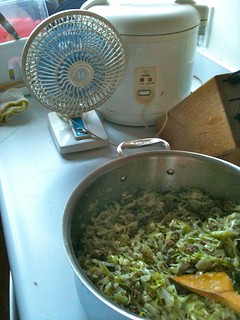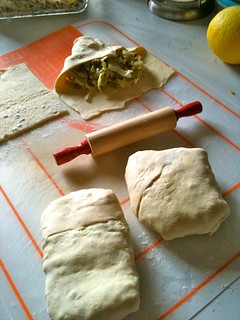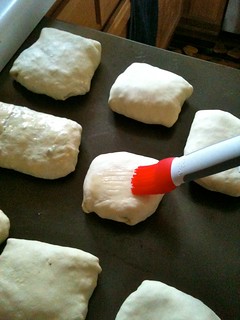When we got married eons ago (okay, it was 12 years ago, not eons) a friend of mine gave us a Japanese rice cooker as a wedding gift. It's a great rice cooker, except that it's huge (it makes 10 cups of rice). Now, if you have an automatic rice cooker, yours might be like mine and have little lines on the inside so you know how high to fill it up with water, depending on how many cups of rice you're making. It's helpful to have the lines, but my rice cooker is so big that the lines start at three cups, which is way more than we eat at one sitting. "Why don't you just make one or two cups?" you may ask. Well, I've tried and the rice always comes out overcooked or undercooked. So, just to be on the safe side, I always make at least three cups of rice to ensure good rice. Which means I almost always have leftovers. And when there's leftover rice, what does any Asian make? Fried rice, of course.
I usually make a simple egg and green onion fried rice as a side dish, nothing fancy or complicated. I use a huge wok (which I think we also got as a wedding gift) just because it seems more authentic that way. With my old stove I always felt I didn't have enough fire power (aka BTUs) to properly cook fried rice, so I was eager to test out my new stove's largest burner, which has a pretty enormous flame.
I tried out a couple of different things this time around, wondering if it would add more flavor. Basically, this is a variation on my usual lazy person's fried rice recipe. Everyone has their own way of making fried rice -- the beauty of the dish is that it's adaptable and you can make it all kinds of ways with all kinds of ingredients and it turns out pretty well.
I think it goes without saying that you need to use leftover rice that's at least a day old (mine was barely a day old and I feel like I should've waited another day). Also, this is not necessarily a healthy dish. It's called
fried rice for a reason; you'll use a lot of oil.
I don't have any specific measurements for the ingredients for this recipe -- just use as much as you want of each flavor.
Ingredients:
- leftover rice (at least a day old) --> We eat Japanese short grain rice (i.e., "sticky" rice) that's half way between brown rice and white rice. Because it's a short grain rice it really needs at least two days in the fridge to lose its stickiness and crumble a bit. I don't think you have this problem with longer grain rice.
- vegetable and sesame oil
- green onions, green parts finely chopped
- green onions, white parts chopped into 1~2 inch pieces
- garlic cloves, smashed
- ginger, sliced
- eggs, beaten (I used three)
- soy sauce
- white pepper
- MSG (totally optional)
The aromatics on the ingredient list don't reflect what you see in the photo above. In hindsight, instead of mincing the aromatics, I should've kept them as fairly large pieces because I wanted them to enhance the flavor of the oil. It was hard to cook the minced aromatics in the oil and fish them out with a fine sieve before they burned.
Step 1: Whisk the eggs in a bowl while heating some oil in the wok (more oil than you would usually use to cook scrambled eggs). When the oil is hot, pour in the egg and cook until the edges start to slightly furl up but the middle is still wet and uncooked. Gently fold in the edges of the egg to the middle and give it one or two scrambles with a spatula before sliding the undercooked egg onto a plate. Set aside.
Step 2: Heat a fair amount of vegetable oil (I probably used at least two tablespoons) with some sesame oil in the wok. Add the aromatics (white part of the green onions, garlic, ginger) and cook over medium heat until golden and, guess what? aromatic! Scoop them out before they burn. Since I used minced aromatics I set it aside to add back into the fried rice later. But if you're using larger chunks of aromatics you can toss it out or chop it up to use in your dish.

Step 3: Heat more vegetable oil in the wok; it should be hot. Break of up the rice before adding it to the wok. Make sure the oil gets evenly distributed on the rice and continue "frying." You should see steam coming up off the rice; you want it to dry out and the grains to separate. Once that happens, add the green part of the green onion and heat just a bit longer. Pour in one to two tablespoons of soy sauce around the side of the wok and toss the rice. Add the eggs and aromatics (if you want to) back in. Season with white pepper to taste. If you feel it needs more saltiness, add more soy sauce, salt, or -- gasp! -- MSG.

Step 4: Enjoy! We're going through our hot week here in Los Angeles so I was already sweating up a storm making the fried rice. I didn't have the energy to cook much more so I made the easiest chicken dish in the world: garlic chicken. Season skinless, boneless chicken thighs on both sides with pepper and garlic salt (we use Lawry's). Cook on medium high in some oil. That's it, and the kids
love it!


























